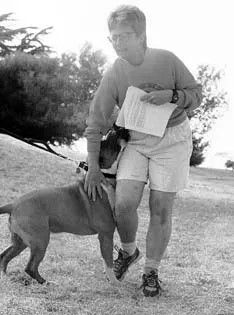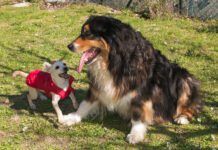HUMPING PROBLEMS IN DOGS: OVERVIEW
1. Watch for early signs of mounting, and take appropriate steps to discourage them as soon as they arise.
2. Neuter your male dog sooner, rather than later.
3. Use “Good Manners” training and a “Say Please” program (described below) to create structure in your household and give yourself a control advantage.
4. Seek assistance from a positive trainer/behavior consultant if you’re not making progress on your own, or if you don’t feel comfortable addressing the behavior on your own.
Luke had been at the shelter for more than a month, and the staff was delighted when the two-year-old Cattle Dog mix was finally adopted to what seemed like the perfect home. Introductions at the shelter with the adopter’s other dog went reasonably well – although the two didn’t romp together, they seemed perfectly willing to peacefully coexist. Luke went to his new home just before Christmas. Before New Year’s, he was returned.
Her cheeks damp with tears, the adopter explained that the two dogs were fighting. Luke insisted on mounting Shane. Shane would tolerate the rudeness for a while, but when he finally let Luke know that he found the behavior unacceptable, a battle would ensue. The intensity of the fights was increasing, and the adopter was concerned that one or both of the dogs was going to be badly injured. I discussed the situation with her, and agreed that returning Luke was the right decision.
Dog Mounting is NOT About Sex

First, we’re not talking about sexual behavior displayed by intact male and female dogs used for breeding. High hormone levels and normal sexual responses to other intact dogs are different from “problem mounting.” Sometimes, an owner will report that when her young dog plays with other dogs, he gets overstimulated and will attempt to mount another dog or even just “air-hump” for a few seconds. In preadolescent and neutered dogs, this is generally a byproduct of physiologic arousal – an inappropriate response triggered by sensory stimuli, motor activity, and/or emotional reactivity.
The dog who is most likely to be reported as having a real mounting problem is the dog who routinely mounts people, or, like Luke, who mounts other dogs to the point of provocation. This sort of mounting behavior has nothing to do with sexual activity. Rather, it’s often a social behavior, and sometimes a stress reliever. Nonsexual mounting of other dogs is generally a dominance, control, or challenge behavior, although when practiced by puppies it’s primarily about play and social learning, beginning as early as 3-4 weeks. Mounting of humans is strictly nonsexual; it may be about control, it can be attention-seeking, and it can be a stress-reliever.
Dogs will also mount inanimate objects. Our Pomeranian will hump our sofa cushions if we leave the house and take all the other dogs with us. While some dogs do sometimes masturbate for pleasure, in Dusty’s case I’m convinced he’s not seizing a moment of privacy for self-gratification, but rather mounts the cushions as a way to relieve his stress of being left home alone.
In fact, if dogs did wait for some private time to engage in their mounting behaviors, most owners would be far less concerned about it. But dogs, having no shame, are far more likely to take advantage of a visit from the boss or the in-laws to display their leg-hugging prowess. Regardless of how much you love your dog, it’s embarrassing to have him pay such inappropriate attention to your guests.
Get Your Dog to Stop Humping
Like a good many canine behaviors that we humans find annoying, inconvenient, or embarrassing, mounting is a perfectly normal dog behavior. And like other such annoying, inconvenient, and embarrassing behaviors, it’s perfectly reasonable for us to be able to tell our dogs to stop mounting!
Brief bouts that involve mounting of other dogs in canine social interactions might be acceptable, as long as they don’t lead to bloodletting or oppression of the mountee. Mounting of human body parts rarely is, nor is mounting that, as in Luke’s case, leads to dogfights.
So, if there’s a Luke whose mounting behavior is wreaking havoc in your family pack, what do you do?
The longer your dog practices his mounting behavior, the harder it is to change. So it’s logical that the sooner you intervene in your dog’s unacceptable mounting, the better your chances for behavior modification success.
Neutering is an obvious first step. A 1976 study found an 80 percent decrease in mounting behavior following castration. (This is far more often a male dog behavior problem than a female one.) The same study determined that within 72 hours of surgery, the bulk of hormones have left the dog’s system. Since mounting is partially a learned behavior as well as hormone-driven, the extent to which neutering will help will be determined at least in part by how long the dog has been allowed to practice the behavior. Just one more strong argument for juvenile sterilization, between the ages of eight weeks and six months, rather than waiting for your dog to mature.
When Your Dog Humps Other Dogs
Luke, at age two, had been practicing his mounting behavior for many months. In addition, as a mostly Cattle Dog, he was assertive and controlling. When Shane attempted to voice his objections, Luke let him know that he would brook no resistance. Shane, a Shepherd/Husky mix, also had an assertive personality, so rather than backing down in the face of Luke’s assertions of dominance, he fought back. Neither dog was willing to say “Lassie,” and so the battles escalated.
In contrast, we later introduced Shane to a somewhat timid but playful four-month-old Lab puppy. Dunkin also attempted to mount Shane in puppy playfulness. But when Shane snapped at Dunkin, the pup backed off apologetically; in a short time the two were playing together, with only occasional puppy attempts to mount, which were quickly quelled by a dirty look from the older dog. No harm, no foul.
Similarly, you will need to work harder to convince your adult, well-practiced dog to quit mounting other dogs than you will a young pup, and there’s more potential for aggression if the recipient of unwanted attentions objects.
With both young and mature dogs, you can use time-outs to let your dog know that mounting behavior makes all fun stop. A tab (short, 4- to 6-inch piece of leash) or a drag-line (a 4- to 6-foot light nylon cord) attached to your dog’s collar can make enforcement of time-outs faster and more effective when you have to separate dogs – as well as safer.
Set your dog up for a play date with an understanding friend who has an understanding dog. Try to find a safely fenced but neutral play yard, so that home team advantage doesn’t play a role. If a neutral yard isn’t available, the friend’s yard is better than your own, and outdoors is definitely preferable to indoors.
When you turn the dogs out together, watch yours closely. It’s a good idea to have some tools on hand to break up a fight, should one occur.
If there’s no sign of mounting, let them play. Be ready to intervene if you see the beginning signs of mounting behavior in your dog. This usually occurs as play escalates and arousal increases, if it didn’t happen at the get-go.
As a first line of defense, try subtle body-blocking. Every time your dog approaches the other with obvious mounting body postures, step calmly in front of your dog to block him. If you’re skilled, you may be able to simply lean your body forward or thrust out a hip or knee to send him the message that the fun’s about to stop. This is more likely to work with a younger dog, who is likely to be less intense about his intent to mount. Be sure not to intervene if your dog appears to be planning appropriate canine play.
If body blocking doesn’t work, as gently and unobtrusively as possible, grasp your tab or light line, then cheerfully announce, “Time out!” and lead your dog to a quiet corner of the play yard. Sit with him there until you can tell that his arousal level has diminished, and then release him to return to his playmate. If necessary, have your friend restrain her dog at the same time so he doesn’t come pestering yours during the time out.
Keep in mind that the earlier you intervene in the mounting behavior sequence, the more effective the intervention, since your dog has not had time to get fully involved in the behavior. Also, it’s important that you stay calm and cheerful about the modification program. Yelling at or physically correcting your dog increases the stress level in the environment, making a fight more likely, not less.
With enough repetitions, most dogs will give up the mounting, at least for the time being. With an older dog for whom the habit is well ingrained, you may need to repeat your time-outs with each new play session, and you may need to restrict his playmates to those who won’t take offense to his persistently rude behavior. With a pup or juvenile, the behavior should extinguish fairly easily with repeated time outs, especially if he is neutered. Just keep an eye out for “spontaneous recovery,” when a behavior you think has been extinguished returns unexpectedly. Quick re-intervention with body blocks or time-outs should put the mounting to rest again.
Does Your Dog Only Hump Humans?
This embarrassing behavior is handled much the same way as dog-dog mounting. One difference is that you must educate your guests as to how they should respond if your dog attempts his inappropriate behavior.
Another difference is that some dogs will become aggressive if you physically try to remove them from a human leg or other body part. It works best to set up initial training sessions with friends who agree to be human mounting posts for training purposes, rather than relying on “real” guests to respond promptly and appropriately, at least until your dog starts to get the idea.
For your average, run-of-the-mill human mounting, ask your guests to stand up and walk away if your dog attempts to get too cozy. Explain that it is not sexual behavior, but rather attention-seeking, and anything they try to do to talk him out of it will only reinforce the behavior and make it worse. You can also use a light line here, to help extricate your friends from your dog’s embrace, and to give him that oh-so-useful “Time out!” If the behavior is too disruptive, you can tether the dog in the room where you are socializing, so he still gets to be part of the social experience without repeatedly mugging your guests.
If your dog becomes aggressive when thwarted, he should be shut safely away in his crate when company comes. Social hour is not an appropriate time to work on aggressive behavior – it puts your guests at risk, and prevents all of you from being able to relax and enjoy the occasion.
If your dog becomes growly, snappy, or otherwise dangerous when you try to remove him from a human, you are dealing with serious challenge and control behavior. You would be wise to work with a good behavior consultant who can help you stay safe while you modify this behavior. The program remains essentially the same – using time outs to take away the fun every time the behavior happens – but may also involve the use of muzzles, and perhaps pharmaceutical intervention with your veterinarian’s assistance, if necessary.
Do Dogs Masturbate?
Dog owners are often surprised to discover that some dogs masturbate. Our diminutive Dusty discovered early in life that he was just the right height to stand over a raised human foot and engage in a little self-pleasuring if the person’s legs were crossed. We squelched that behavior as soon as we realized what the heck he was doing.
There’s no harm in it, as long as the objects used are reasonably appropriate (say, a washable stuffed animal that’s his alone, as opposed to your favorite sofa cushions), and it doesn’t become obsessive. Removing an inappropriate object or resorting to time outs can redirect the behavior to objects that are more acceptable.
I’ve also known dogs to engage in push-ups on carpeting as a way to enjoy self-stimulation. You can use the time out if your dog chooses to do it in front of your guests, or whenever he does it in the “wrong” room (such as on the living room Berber), and leave him alone when he’s in the “right” room (such as on the indoor-outdoor carpet on the back porch).
If your dog practices the behavior to a degree that appears obsessive – a not uncommon problem in some animals, especially in zoos – then you may need some help with behavior modification.
A behavior is generally considered obsessive when it is causes harm to the animal or interferes with his ability to lead a normal life. If your dog is rubbing himself raw on the Berber carpet, or spends hours each day having fun in the bedroom, that’s obsessive behavior. There are behavior modification programs that can help with canine obsessive/compulsive disorders, and they often require pharmaceutical intervention, especially if the obsession is well-developed.
Other Ways to Modify Humping Behavior
In addition to specific behavior modification programs for mounting behavior, a “Say Please” program can be an important key to your ultimate success. No, we’re not suggesting you allow your dog to do inappropriate mounting if he says “please” first! A Say Please program requires that he perform a deferent behavior, such as “sit,” before he gets any good stuff, like dinner, treats, petting, or going outside. This helps create structure in the pack, and constantly reminds him that you are in charge and in control of all the good stuff. Since a fair amount of mounting has to do with control, Say Please is right on target.
“Good Manners” classes are also of benefit when you are mounting your defense against your mounting dog’s behavior. If he’s trained to respond promptly to cues, the “ask for an incompatible behavior” technique can serve to minimize mounting. If you see your dog approaching a guest with a gleam in his eye, your “Go to your place” cue will divert him to his rug on the opposite side of the room. He can’t “Down” and mount a leg at the same time. Nor can he do push-ups on the rug if he is responding to your request for a “Sit.”
If you start early and are consistent about discouraging your dog’s inappropriate mounting, you should be successful in making the embarrassing behavior go away.
Pat Miller, WDJ’s Training Editor, is a Certified Pet Dog Trainer, and past president of the Board of Directors of the Association of Pet Dog Trainers. She is also the author of, The Power of Positive Dog Training and, Positive Perspectives: Love Your Dog, Train Your Dog.







Ive just adopted a 3yr old bulldog’ he likes my 28yr old son by wanting to hump him all the time and always licking our legs or arms
No response? Sad that after 2.5 years there are no answers for you. Doesn’t say much for the site blogger nor the people who are using …. or not, the site.
The actions of the dog are not unusual, and the licking can most likely be to get salt that is on our bodies….especially if your son had been working beforehand.
my dogs are both neutered males. one is older by 3 years one is a beagle the older one. and the younger one is a pug jack russell mix. the beagle has never mounted anything or anyone. his only motive in life is to be free outside to follow his nose and to eat what he wants. no dominance issues or anything hes very chill. the other one has anxiety issues, hes always nervous and as soon as we get ready to go for a walk he will start mounting the beagle. its the only time he does this and not all the time only sometimes. i dont know what his triggers are bc we can go for a walk in the morning and hes fine but then the next day he will mount the other dog. he doesnt do it excessively most times its when leaving or entering the house so i thought it was about dominance and his trying to show the beagle he was the boss of inside. any thoughts? i dont see it as a problem bc its so mild and doesnt start fights (the beagle is so patient).
We have 2 newly adopted dogs, related ( daughter, father) . These dogs were not fixed early on. Girl age 4 boy age 9. Girl recently fixed, gone for prob 8 hours, now a once sweet and laid back boy dog is now crazy!!! Whining jumping her, won’t leave her alone chases her everywhere . Had to separate them he was nosing her in her incision hurting her. He has just been fixed hoping this helps but I think he is so attached to her now has anxiety .
I have just adopted a female dog but she wants to jump on my other female dogs back, it seems aggressive.
Do you think this is a sign of dominance?
Yesterday we brought home Zeus a black lab puppy. Our older dog, Oliver a 12 year old wiener dog who has had behavioral problems in the past and separation anxiety, will not leave the puppy alone for one second. Oliver continuously tries to mount the puppy and dominate him. When I have tried to remove him from the position he growls and snaps at me. Just a few days before bringing Zeus home Oliver was a loving dog with a barking issue, now he has turned aggressive if he not allowed to have access to the puppy. Oliver also is not fixed, I am wondering if there are any solutions to this. We have had to resort to crating the older dog just so that the puppy, and we have been able to take a break. Please help.
Get rid of Oliver and replace him with a dog that will be more suited to the pack. You will save a lot of headaches.
Really “get rid of” if only it were that easy to rid the humans that don’t fit🙄
My best friend has a Male Neutered Chihuahua he’s about 7 months (Fig) and He’s been lately trying to hump my puppy 11 weeks old not fixed male chihuahua (Billy), Billy usually will get away running and playing, but the behavior on Fig is increasing and getting annoying, before it happened when they were actively playing, but now it happens even is Billy is laying down quietly. What can we do?
Our Chihuahua is a female and has been fixed since she was 6 months old. She is 5 years old now. Sometimes when my husband and I are having sex she comes out of no where and jumps up on the bed quietly then goes to humping my husbands leg or tries to hump his arm. I mean serious humping and out of breath. It is the only time she does it. I have to get up and go put her in the bathroom with pee pads and water until we get finished.
My dog is a make rottie bullmastiff mix. He is 8 but very playful. He used to mount everything when we first rescued him 4 years ago. Since then he has not exhibited that behavior. We recently adopted a 3 year old female can corso mix and she is a complete sweetheart. It’s been about a month we crate her at night and when they’re alone. They seem ok. She can get playful and he tolerates it a plays for a bit but tires easily. He will get a squeaky toy and run up and throw it at her. But he attempted to mount her recently in the yard. She’s so much smaller than him i was afraid he would hurt her. Hes 130lbs and she’s about 60.
We are currently considering adopting a male cane corso/doberman mix (his dna said 50% dobie and 38 cane corso, with italian mastiff and rottie) and your comment made me wonder if you know what your female is mixed with? One of the reasons we are not 100% sure about adopting him is because we are worried he will be huge! He is so sweet and smart, and we really thought he was a hound mix.
I have a rescued 15.5 year old female who has one eye and arthritis and she lost her bonded buddy to cancer 4 months ago. I was crying myself to sleep every night from losing him and finally decided to get another dog. I adopted a 10-year from the shelter three days ago. He was neutered a long time ago.. He is my shadow, was apparently the only dog in his previous home and spoiled. He is mounting my female relentlessly and she is too old and weak. She had been a puppy mill mom for 4 years before being rescued. We have to CONSTANTLY monitor them. She snapped at him. I think he drew some blood. He is undeterred. We are blocking him, grabbing him by the scruff of the neck, putting him on a leash. Nothing slows him down. I’ve only had him 3 days and he’s really a sweet boy and so happy to be out of the shelter. I’ve started leash training and he’s learning that. I’ve never had a dog mounting problem before. Ugh. I’d love suggestions.
I have a terrier mix and her mix pup which is a chuaua and they both are not neutered ages 7 and 5 . I didn’t keep them my x husband passed and I was the only one she would have anything to do with after his passing . And the 5 yr old daughter due to curtances I was asked to keep her well I’ve had both of them
For 2 yrs now .. Do not get along well now both are coming in the daughter humps the mother and she lets her what the heck is really going on with these 2 . Someone anyone ever been thorough this . I NEED ADVICE !
Awesome article, it helped answer some questions but not all of them…
would you have any idea why would a senior male dog would EXCESSIVLY lick, hump, urinate and xxx on a senior spayed female to the point of licking her bald, bleeding, and joint dislocation (to both himself and her) while growling at anyone who intervenes?
Separation causes him to HOWL (basically scream) the entire time, circling my door or the back door then he starts to pee only on my things?
I wish I was overexaggerating, and yes I still intervein despite his growling.
They were not raised together, and he’s my roommates dog
she’ll be moving with me in the next day or so, she’ll be safe once again..